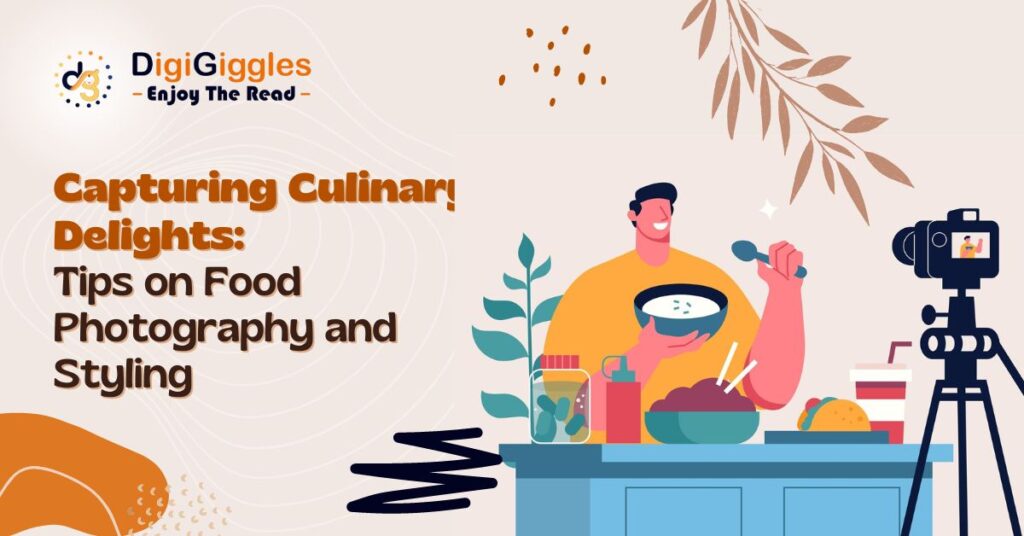
Using our cameras to capture the beauty of food has become popular in the social media age, thanks to food blogs and Instagram. The goal is to entice the viewer by displaying the dish in a single frame enticingly and beautifully. It’s evolved into a distinct art form.
The ability to arrange and shoot mouthwatering dishes is a valuable talent, whether you are an aspiring food blogger, a food enthusiast, a traveler, or a professional food photographer. To help you present your culinary masterpieces in the most mouth-watering way, this blog will offer you crucial advice on food photography and styling.
1. Lighting is Key
Good lighting is the foundation of stunning food photography. Natural light, diffused through curtains or by shooting near a window, provides a soft, even glow that enhances the appeal of your dishes. Avoid harsh, direct sunlight, which can create strong shadows.
2. Choose the Right Angle
The angle from which you photograph your food can make a significant difference. The most common angles for food photography are:
- Top-down (Flat Lay): Ideal for neatly arranged dishes, overhead shots provide a clean, organized look.
- 45-Degree Angle: A slight angle from the side creates depth and showcases layers in dishes like burgers and cakes.
- Eye-Level: Shooting at the same level as your food can create a personal and immersive feel, especially for close-up shots of individual items.
3. Composition and Styling
Use Props: Select props that complement the food and tell a story. Think about utensils, napkins, and ingredients. But don’t overcrowd; less is often more.
Balance Colours: Consider the colour wheel when selecting props and backgrounds. You can use complementary or contrasting colours to make your food pop.
Texture Matters: Highlight the texture of your dishes. Whether it’s the crispy edges of a pie crust or the gooeyness of melted cheese, texture adds depth to your photos.
4. Depth of Field
Experiment with the depth of field to create a sense of focus on the main subject while blurring the background. This can be achieved using a wide aperture lens(low f-number) for a shallow depth of field, or a narrow aperture lens(high f-number) for more background detail.
5. Be Mindful of the Background
Choose your background carefully, it should complement the main subject, i.e. the food. The background should not be jarring to the eyes. A plain, uncluttered background or a surface, like a wooden or marble table, can enhance your image. Ensure there are no distractions.
6. Enhance your image
Use a photo editing software to fine-tune the captured images. Adjust exposure, contrast, saturation, and sharpness. Avoid over-editing as it is not soothing on the eyes.; The goal is to enhance, not distort your image.
7. Experiment with Angles and Perspectives
Food photography is an art, so don’t be afraid to experiment. Try various angles, perspectives, and focal points to discover the most captivating way to present your dish. Capture details, like steam rising from a hot dish or a drizzle of sauce.
8. Keep It Fresh
Freshness is key in food photography. Capture your dishes as soon as they’re ready, to maintain their appeal. Use tricks like misting water on fruits and veggies to keep them looking fresh during the shoot.
9. Tell a Story
Food photography is more than just showcasing a dish; it’s about conveying a story or emotion. Whether it’s a cozy homemade meal or a vibrant summer salad, let your photos tell the viewer something about the food’s context and character. Craft your narrative accordingly.
Munching Ahead
Food photography and styling is an art that requires practice and creativity. With the right lighting, angles, composition and post-processing techniques, you can make your culinary creations not only look delicious but also tell a mouthwatering story. So, whether you’re sharing your culinary masterpieces on social media or starting a food blog, use these tips to capture the essence of your dishes and make your audience crave every bite.